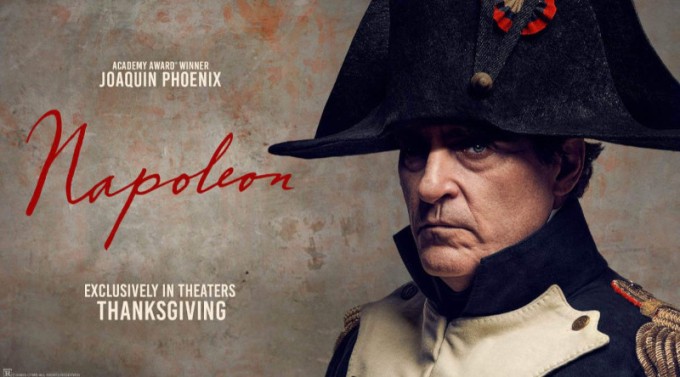There has been a long tradition of films about Napoleon, especially the silent film classic of 927 by Abel Gance with its split screen technique. Since then many stars have played Napoleon, including Marlon Brando (Desiree, 1954), and Rod Steiger, (Waterloo, 1970). He is a familiar historical figure. He is familiar cinema figure.
…which means that audiences will be bringing their own presuppositions about Napoleon to this interpretation, admiration for Napoleon and his leadership, especially in battle, intrigued curiosity about his ambitions and achievement, interest in the range of battles, no Trafalgar here, but Toulon, Austerlitz, Borodino and, of course, Waterloo.
There has been great admiration for the film. There has been some high criticism by those who feel they know Napoleon very well and are determined to highlight deficiencies in the writing by David Scarpa and in Ridley Scott’s direction. But, those caught up in the film, as was this reviewer, it is almost 3 hours of immersion in, firstly, the French Revolution and the execution of Marie Antoinette, the bloodthirsty crowds, the Republican independence; secondly, in the portrait of Napoleon himself: lowly from Corsica, skilled in battle, and tactics, perhaps, rather than overall strategies (which led to a number of victories but also to several downfalls, Moscow and Waterloo). And, thirdly, this immersion, lavish sets and decor, costumes of the period, as well as the close-ups of battle, cannon fire deafening, thunder of troops on horseback, the hand-to-hand combat make an impact.
There is also the question of the casting of Joaquin Phoenix as Napoleon. Ridley Scott directed Phoenix as the Emperor in Gladiator, (2000 film), and the actor receiving an Oscar nomination. He has had a long career playing character actors, even to playing an older Jesus in the film, Mary Magdalene (2018 film), and winning an Oscar for playing Joker (and he will appear in the sequel). Phoenix is rather short, especially in comparison with Vanessa Kirby’s Josephine, somewhat squat, not exactly an oil painting (although there are some sequences where he and Josephine pose for the official painter, Jacques-Louis David).
As portrayed by the screenplay, Napoleon comes across as quite single-minded, ambitious and vain, straightforward in intentions, step-by-step tactics, rather humourless, infatuated with Josephine but very blunt in his dealings with her at times, especially sexually, and preoccupied with having an heir.
Most audiences will know what happens to Napoleon and the end, disgraced, after the trek back from Moscow, exiled to Elba, his immediate escape, the ambitions at Waterloo.. Unlike defeated heroes in plays and novels, Napoleon did not tragically commit suicide. Rather, he went to the faraway island of St Helena for six years. Overreaching ambition and its consequences.
Audiences prepared for a cinema re-interpretation of Napoleon will be interested. Those who have formed their ideas about Napoleon have emerged as quite dissatisfied. This reviewer saw and enjoyed the film on the IMAX screen – and Napoleon himself would have wanted IMAX, or a large cinema, rather than on streaming where he will eventually find a more permanent home (a bit like six years at St Helena after the vastness of his battles).
Reviewed by Fr. Peter Malone, MSC
Further info re NAPOLEAN
UK, 2023, 158 minutes, Colour.
Joaquin Phoenix, Vanessa Kirby, Tahar Rahim, Rupert Everett, Mark Bonnar,
Paul Rhys, Ludivine Sagnier, Sinead Cusack, Ian McNeice.
Directed by Ridley Scott.





